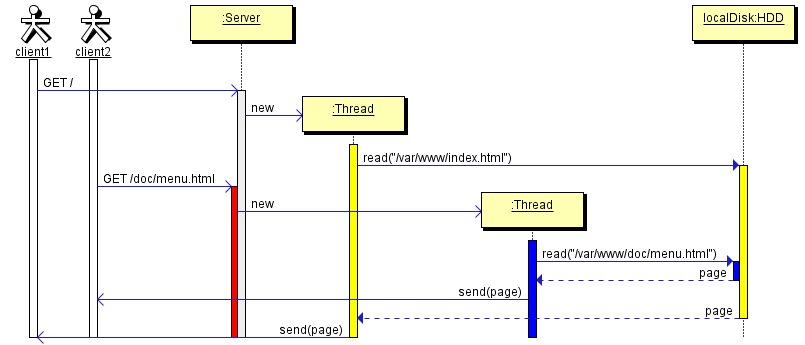Introduction
Quick Sequence Diagram Editor is a tool for creating UML sequence diagrams from textual descriptions of objects and messages that follow a very easy syntax (http://sdedit.sourceforge.net- /enter_text- /index.html).
It supports actors, constructors, destructors, threads and on-diagram comments that can be used to represent conditions or loops.
Thanks to the FreeHEP Vectorgraphics library, diagrams can be exported in various formats, including PDF, (E)PS, SVG, SWF, EMF, GIF, JPEG.
Quick Sequence Diagram Editor automatically lays out lifelines and messages, there is no need to drag and drop something onto a canvas. So a user should be able to create a nice sequence diagram in a small fraction of the time that one of the grand UML tools would consume.
The aim of the tool is to save you from lots of the stupid work that WYSIWYG applications require, by trading off not too much flexibility. It beats these applications by far when it comes to insert or remove objects and messages. This can be done by just inserting or removing a line of text, the tool will do all the rest.
Copyright
Copyright (c) 2006 - 2008, Markus Strauch. All rights reserved.
License
This program is released under the BSD license: Redistribution and use in source and binary forms, with or without modification, are permitted provided that the following conditions are met: Redistributions of source code must retain the above copyright notice, this list of conditions and the following disclaimer. Redistributions in binary form must reproduce the above copyright notice, this list of conditions and the following disclaimer in the documentation and/or other materials provided with the distribution. THIS SOFTWARE IS PROVIDED BY THE COPYRIGHT HOLDERS AND CONTRIBUTORS ``AS IS'' AND ANY EXPRESS OR IMPLIED WARRANTIES, INCLUDING, BUT NOT LIMITED TO, THE IMPLIED WARRANTIES OF MERCHANTABILITY AND FITNESS FOR A PARTICULAR PURPOSE ARE DISCLAIMED. IN NO EVENT SHALL THE COPYRIGHT OWNER OR CONTRIBUTORS BE LIABLE FOR ANY DIRECT, INDIRECT, INCIDENTAL, SPECIAL, EXEMPLARY, OR CONSEQUENTIAL DAMAGES (INCLUDING, BUT NOT LIMITED TO, PROCUREMENT OF SUBSTITUTE GOODS OR SERVICES; LOSS OF USE, DATA, OR PROFITS; OR BUSINESS INTERRUPTION) HOWEVER CAUSED AND ON ANY THEORY OF LIABILITY, WHETHER IN CONTRACT, STRICT LIABILITY, OR TORT (INCLUDING NEGLIGENCE OR OTHERWISE) ARISING IN ANY WAY OUT OF THE USE OF THIS SOFTWARE, EVEN IF ADVISED OF THE POSSIBILITY OF SUCH DAMAGE.
Home page
http://sdedit.sourceforge.net/index.html
Examples
The following is an example of the raw input code and output that is generated, in this case as a PNG.
The full syntax is available (http://sdedit.sourceforge.net- /enter_text- /index.html)

Source
(start sdedit) bfs:BFS[a] /queue:FIFO someNode:Node node:Node adjList:List adj:Node bfs:queue.new bfs:someNode.setLevel(0) bfs:queue.insert(someNode) [c:loop while queue != ()] bfs:node=queue.remove() bfs:level=node.getLevel() bfs:adjList=node.getAdjacentNodes() [c:loop 0 <= i < #adjList] bfs:adj=adjList.get(i) bfs:nodeLevel=adj.getLevel() [c:alt nodeLevel IS NOT defined] bfs:adj.setLevel(level+1) bfs:queue.insert(adj) --[else] bfs:nothing to do [/c] [/c] [/c] bfs:queue.destroy() (end sdedit)
Multithreading example
When multithreading is enabled (it can be switched on and off in the preferences dialog or the Edit menu), you can create diagrams that model arbitarily many sequences running in parallel, not just a single one. The sequences can (at your option) be distinguished by the colours of their corresponding lifelines. There is still no real parallelism, as the messages must be specified in some order. This order can be interpreted as one of many possible interleavings of the threads. A single-processor system would execute them in a similar way.

Source
(start sdedit) client1:Actor client2:Actor webServer:Server[a] /t1:Thread[a] /t2:Thread[a] localDisk:HDD client1:webServer.GET / webServer[,0]:>t1.new t1[,1]:page=localDisk.read("/var/www/index.html") client2:webServer.GET /doc/menu.html webServer[,2]:>t2.new t2[,3]:page=localDisk.read("/var/www/doc/menu.html") t2:client2.send(page) t1[,1]:client1.send(page) t1:stop t2[,3]:stop (end sdedit)
To send feedback on this topic email: naturaldocsplus@gmail.com
© Some Rights Reserved. see License